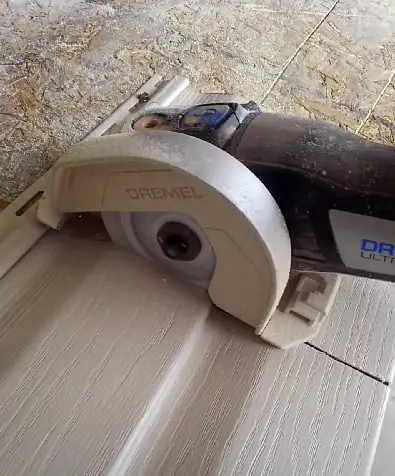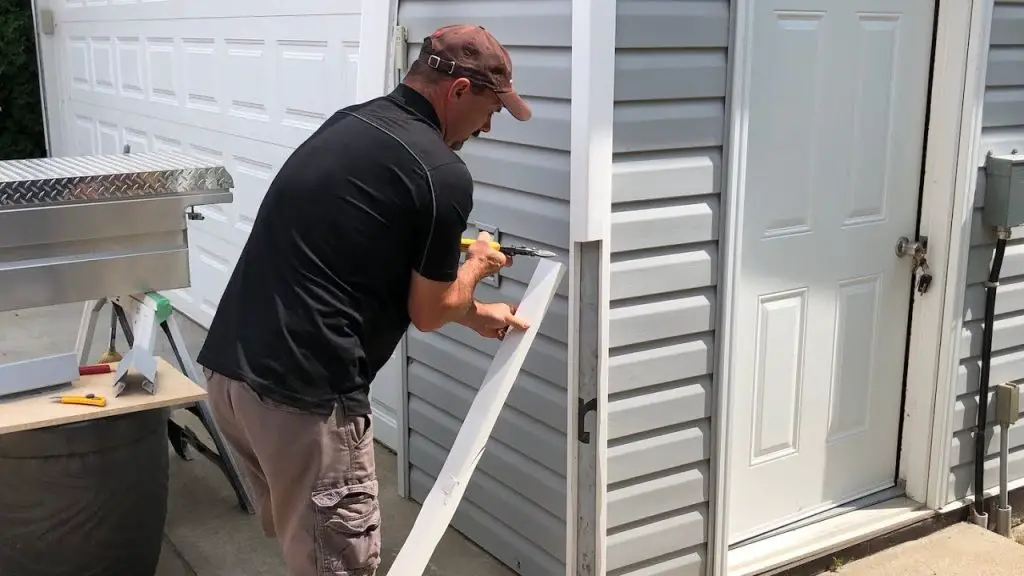How to cut Vinyl Siding Corners? If you’re looking to cut vinyl siding corners, there are a few things you need to know. First, you need to make sure that you have the right tools. You’ll need a saw with a fine-toothed blade, as well as a measuring tape and chalk line.
Once you have your tools, measure the area where you’ll be cutting the vinyl siding corner and mark it with a chalk line. Then, using your saw, carefully cut along the chalk line. Be sure to wear safety goggles while doing this!
- Decide where you want to make the cut and mark it with a pencil
- Place the vinyl siding cutter against the marked line
- Squeeze the handles of the cutter together to score the vinyl siding
- Snap the scored piece of vinyl siding off at the marked line

Best Way to Cut Vinyl Siding Corners
If you’re working with vinyl siding, you’ll need to cut the panels to fit around corners. Here are a few different ways to do this:
Use a power saw
To cut vinyl siding with a power saw, you will need to use a circular saw with a fine-toothed blade. Set the blade depth to just barely cut through the vinyl siding. You may need to make multiple passes to cut through the thickness of the siding. Be sure to wear safety goggles and a dust mask to protect yourself from flying debris.

Use a utility knife
If you don’t have access to a power saw, you can use a utility knife to score the vinyl siding along your desired cut line. To cut vinyl siding with a utility knife, first, score the siding along the line you want to cut. Be sure to score the siding deeply enough so that the blade will cut through the material. Next, holding the utility knife at a 90-degree angle slowly and carefully cut along the scored line.

Use tin snips ✂️
Tin snips are a great way to cut vinyl siding corners. They are easy to use and make clean, straight cuts. To use tin snips, simply line up the blade with the vinyl siding and cut through it. For curved or irregular cuts, tin snips may be your best bet. Again, just be sure that the blades of your snips are sharp and designed for cutting plastic.
You Can Use a Circular Saw, Jigsaw, Or Even a Utility Knife
There are many ways to cut sheet metal, but three of the most common methods are using a circular saw, jigsaw, or utility knife. Each method has its own benefits and drawbacks that you should consider before beginning your project. A circular saw is perhaps the most versatile tool for cutting sheet metal.
It can make both straight and curved cuts with ease. However, it can be difficult to control and may create dangerous flying debris. A jigsaw is another option for cutting sheet metal.
It is much easier to control than a circular saw and can make very precise cuts. However, it is not as versatile as a circular saw and cannot make curved cuts. A utility knife is the simplest way to cut sheet metal.
It requires no power source and is very easy to use. However, it can only make straight cuts and is not suitable for thicker pieces of metal.
What are Some Tips for Cut Vinyl Siding Corners
One of the most important aspects of a great vinyl siding installation is getting clean, sharp corners. Here are a few tips to help you get perfect corners every time:
Use a sharp utility knife
A dull knife will cause the vinyl siding to tear, rather than cut, resulting in jagged and uneven edges. Be sure to change your blade often to ensure optimal results.
Score the siding
Before actually cutting the vinyl siding, use your utility knife to score a line where you want the cut to be. This will give you a nice, clean guide to follow when making your cut.
Cut slowly and steadily
Once you’ve scored your line, take your time cutting slowly and steadily along the length of the scored line. Again, going too fast can result in tearing or uneven cuts. 4. Use a straight edge – If possible, use a straight edge (such as a level or ruler) to help guide your cuts and achieve perfectly straight lines.

How do you cut angles for vinyl siding?
In order to cut angles for vinyl siding, you will need a power saw with a fine-toothed blade. You will also need to measure the angle that you need to cut and mark it on the vinyl siding. Once you have the angle marked, you can line up the blade of the power saw with the mark, and cut along the line.
If you are not comfortable using a power saw, you can also use a hand saw or a utility knife. However, these methods will take longer and be more difficult.
How do you splice outside corners on vinyl siding?
To splice outside corners on vinyl siding, you will need to use a corner splice kit. This kit will come with two vinyl splice pieces and four corner mounting plates. To install, simply line up the two vinyl splice pieces at the corner and screw the corner mounting plates into place.
If you’re looking for a more permanent solution, you can also use J-channel to create an outside corner. To do this, simply cut two pieces of J-channel to the desired length and screw them into place at the corner.
Importance of Blade to cut vinyl Corner
If you are using a dull blade, you are more likely to cut yourself. A sharp blade will make it easier to cut through food and will also help you avoid accidents.
If you are using a power tool to cut through material, it is important to go slowly and be careful not to overcut the corner. Power tools can easily damage the material if they are not used correctly, so it is important to take your time and be precise when cutting.
How To Replace A Vinyl Siding Corner
How to make horizontal cuts
Circular saws are excellent for making short, vertical cuts in vinyl siding, ensuring clean and straight lines without frayed edges, which could lead to issues during sealing.
Procedure:
- Use the measuring tape to determine the correct length for each siding piece. Mark them to indicate their orientation when installed, including details like “top” and “bottom.”
- Employ a fine-toothed cutting blade installed backward for the cleanest cuts.
- Align the vinyl siding with the blade guides at the cutting points – refrain from starting the cut yet; this is to ensure optimal positioning.
- Put on safety goggles, double-check the alignment of guides, and then commence cutting.
- Use the work table as a guide, smoothly removing the excess siding. The carpenter’s square can ensure accuracy; proceed slowly.
- Repeat the process as required.
By following this technique, you can achieve consistently sharp and clean lines every time!
How to make long vertical cuts
Making long vertical cuts is most efficiently done using tin snips. They are not only safer but also provide greater precision compared to a circular saw, which might be too unwieldy for such cuts, resulting in a less smooth and accurate finish.
- Utilize your measuring tape to precisely identify the cutting points on your vinyl siding and clearly mark them.
- Align the designated cutting point with the edge of your table, using a carpenter’s square to ensure a straight and clean cut.
- Secure the siding in place with one hand, and with the other hand, use tin snips to make long cuts along the marked areas. Maintain the snips about ⅔ closed to ensure straight and clean cuts.
- Continue snipping along the length of the siding until you reach the end, repeating the process for additional pieces as needed.
Pro tip: Leave at least two inches of overlap per tab while snipping. This ensures a seamless look and helps prevent drafts during colder months.
Additionally, it’s advisable to keep the cut-off material together. This makes it easier to review your work and simplifies the measurement process for replacement materials, if required later on.
Conclusion
If you’re looking to cut vinyl siding corners, there are a few things you need to keep in mind. First, you’ll need a sharp utility knife or circular saw. Second, make sure to measure twice and cut once.
Third, use a level when cutting so your cuts are straight. Lastly, when using a power saw, be sure to wear eye protection.

I’m John Carry, also known as a woodworker I have been a professional saw expert for over 10 years. I’d work with every type of saw machine out there, and experiment to find which tools work better.
I’m always looking for ways to improve my skills and help those around me. I love my job and am always happy to share my knowledge with others.


